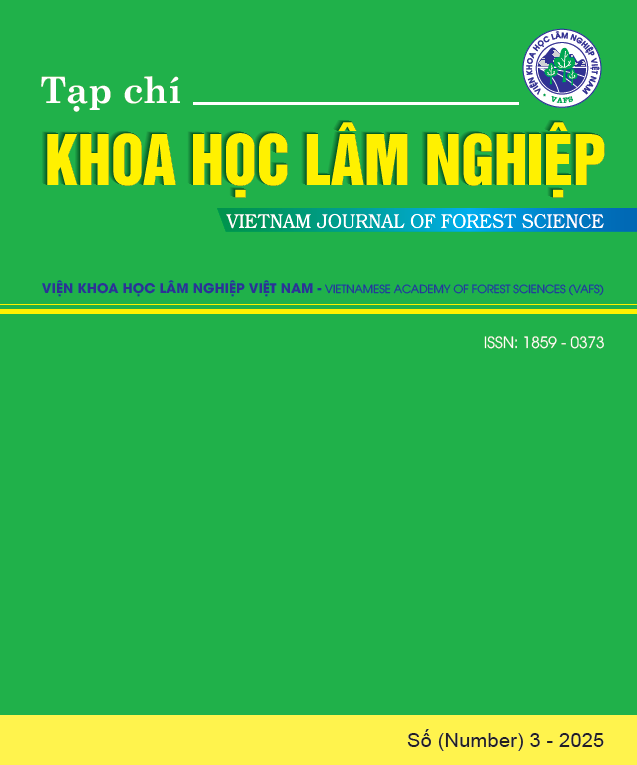COMPARISON OF LAND USE LAND COVER CLASSIFICATION METHODS USING THE RANDOM FOREST ALGORITHM WITH NDVI VERSUS A COMBINED INDEX APPROACH (NDVI, DEM, NDWI, AND NDSI) IN DAK GLONG AND KRONG NO DISTRICTS, DAK NONG PROVINCE
DOI:
https://doi.org/10.70169/VJFS.1060Keywords:
Normalized difference soil index, Normalized difference water index, Normalized difference vegetation index, Digital elevation model, Land use and land coverAbstract
ABSTRACT
This study focuses on evaluating and comparing the classification performance of Land use and land cover (LULC) using the Random Forest (RF) algorithm with two approaches: (i) employing only the Normalized difference vegetation index (NDVI), and (ii) integrating a combination of NDVI, Digital elevation model (DEM), Normalized difference water index (NDWI), and Normalized difference soil index (NDSI) derived from Landsat imagery in Dak Glong and Krong No districts, Dak Nong province. The results indicate that the NDVI-only approach yields relatively low overall accuracy (OA), ranging from 35.89% to 59.35%, with a Kappa coefficient (K) between 0.24 and 0.41. In contrast, the integrated index approach significantly enhances model performance, achieving OA between 81.75% and 86.04%, and K ranging from 0.75 to 0.78. The OA improvement reaches up to 45.86%, while the average K increase is approximately 0.40. The inclusion of DEM, NDWI, and NDSI effectively mitigates spectral confusion and improves the discrimination between spectrally similar land cover classes. Based on these findings, the study recommends applying the integrated NDVI, DEM, NDWI, and NDSI approach in LULC classification tasks using remote sensing data, especially in topographically complex regions such as the Central Highlands, to enhance classification accuracy and the reliability of land use maps for sustainable land and forest resource planning and monitoring. The analysis of land cover changes in Dak Glong and Krong No districts reveals a significant decline in natural forest areas, while planted forests have increased markedly, reflecting a shift in land use towards the development of production forests. At the same time, the areas of bare land, agricultural land, and residential zones have also experienced considerable changes due to socio-economic development and the growing demand for land use.
References
1. Amani M., Ghorbanian A., Ahmadi S.A., Kakooei M., Moghimi A. & Others, 2020. Google Earth Engine Cloud Computing Platform for Remote Sensing Big Data Applications: A Comprehensive Review. IEEE Journal of Selected Topics in Applied Earth Observations and Remote Sensing, 13, 5326–5350. https://doi.org/10.1109/JSTARS.2020.3021052.
2. Amoakoh A.O., Aplin P., Rodríguez-Veiga P., Moses C., Alonso C.P., Cortés J.A., Delgado-Fernandez I., Kankam S., Mensah J.C., Nortey D.D.N., 2024. Predictive Modelling of Land Cover Changes in the Greater Amanzule Peatlands Using Multi-Source Remote Sensing and Machine Learning Techniques. Remote Sens. 2024, 16, 4013. https://doi.org/10.3390/rs16214013
3. Congalton R.G. & Green K., 1999. Assessing the accuracy of remotely sensed data: Principles and practices. Lewis Publishers. Boca Raton FL.
4. Dongping Ming, Tianning Zhou, Min Wang, Tian Tan, 2016. Land cover classification using random forest with genetic algorithm-based parameter optimization. Journal of Applied Remote Sensing, 10(3). DOI:10.1117/1.JRS.10.035021
5. Eduardo S. N., Fernanda Y. W., Maria L. B. T., Erivaldo A., 2024. Assessing Land Use and Cover Changes arising from the 2022 water crisis in Southeast China: A comparative analysis of Remote Sensing Imagery classifications and Machine Learning algorithms. ISPRS TC III Mid-term Symposium “Beyond the canopy: technologies and applications of remote sensing”, 4–8 November 2024, Belém, Brazil.
6. Elumnoh, A., & Shrestha, R. P., 2000. Application of DEM data to Landsat image classification: Evaluation in a tropical wet-dry landscape of Thailand. Photogrammetric Engineering & Remote Sensing, 66(3), 297–304. Retrieved from https://www.asprs.org/wp-content/uploads/pers/2000journal/march/2000_mar_297-304.pdf
7. Gan Y., Wang Q., Lio A., 2023. Tree Crown Detection and Delineation in a Temperate Deciduous Forest from UAV RGB Imagery Using Deep Learning Approaches: Effects of Spatial Resolution and Species Characteristics. Remote Sens. 2023, 15(3), 778; https://doi.org/10.3390/rs15030778
8. Haas J., 2024. Image processing of Sentinel-1 SAR (S-1) and Sentinel-2 multispectral (MSI) (S-2) data for applications in landscape archaeology. Zenodo. doi.org/10.5281/zenodo.10687538
9. Đoàn Duy Hiếu và Nguyễn Thám, 2017. Đánh giá biến động rừng huyện Ia Pa, tỉnh Gia Lai trên tư liệu viễn thám đa thời gian và GIS, Tạp chí Khoa học và Giáo dục, trường Đại học Sư phạm Huế, 2(42)/2017, tr. 116 – 126.
10. Nguyễn Thị Thanh Hương, 2015. Ứng dụng công nghệ viễn thám trong nghiên cứu và quản lý lâm nghiệp. Tạp chí Khoa học và Công nghệ Việt Nam.
11. Nguyễn Thị Thanh Hương, Nguyễn Đức Định, Phan Thị Hằng, Cao Thị Hoài, Nguyễn Thế Hiển, Đặng Ngọc Trí, Ngô Thế Sơn, Đoàn Minh Trung, Châu Thị Như Quỳnh, Hồ Đình Bảo và Ngô Thị Thùy Phương, 2018. Báo cáo thay đổi sử dụng đất tại tỉnh tỉnh Đắk Nông, giai đoạn 2005 - 2017, Tài liệu Hội thảo tập huấn tại tỉnh Đắk Nông. Đại học Tây Nguyên và Sở NN & PTNT Đắk Nông.
12. Ibrahim S., 2023. Improving Land Use/Cover Classification Accuracy from Random Forest Feature Importance Selection Based on Synergistic Use of Sentinel Data and Digital Elevation Model in Agriculturally Dominated Landscape. Agriculture, 13(1), 98. https://doi.org/10.3390/agriculture13010098
13. Lowe B. and Kulkarni A., 2015. Multispectral Image Analysis Using Random Forest”. International Journal on Soft Computing (IJSC), 6(1), February 2015.
14. McFEETERS S. K., 1996. The use of the Normalized Difference Water Index (NDWI) in the delineation of open water features. International Journal of Remote Sensing, 17(7), 1425–1432. https://doi.org/10.1080/01431169608948714
15. Navulur K., 2006, Multispectral Image Analysis Using the Object-Oriented Paradigm, CRC Press.Senf C., Pflugmacher D., van der Linden S., & Hostert P., 2013. Mapping Rubber Plantations and Natural Forests in Xishuangbanna (Southwest China) Using Multi-Spectral Phenological Metrics from MODIS Time Series. Remote Sensing, 5(6), 2795–2812. https://doi.org/10.3390/rs5062795
16. Pelletier, C., Valero, S., Inglada, J., Champion, N., Dedieu, G., 2016. Assessing the robustness of Random Forests to map land cover with high resolution satellite image time series over large areas, Remote Sensing of Environment, 187(2016): p.156–168
17. Schowengerdt, R.A., 2017. Remote Sensing: Models and Methods for Image Processing. Academic Press.
18. Senf, C., Pflugmacher, D., van der Linden, S., & Hostert, P. (2013). Mapping Rubber Plantations and Natural Forests in Xishuangbanna (Southwest China) Using Multi-Spectral Phenological Metrics from MODIS Time Series. Remote Sensing, 5(6), 2795–2812. https://doi.org/10.3390/rs5062795
19. Ur Rehman A., Ullah S., Shafique M., 2021. Combining Landsat-8 spectral bands with ancillary variables for land cover classification in mountainous terrains of northern Pakistan. J. Mt. Sci. 18, 2388–2401 (2021). https://doi.org/10.1007/s11629-020-6548-7
20. Xu H., 2006. Modification of normalised difference water index (NDWI) to enhance open water features in remotely sensed imagery. International Journal of Remote Sensing, 27(14), 3025–3033. https://doi.org/10.1080/01431160600589179.
21. Yibai Xiong, Yan Ma, Lianguo Ruan, Dan Li, Cheng Lu, Luqi Huang, 2022. The National traditinal chinese medicine medical team (Comparing different machine learning techniques for predicting covid 19 severity, Infectious diseases of poverty, munber 19 (2022).









